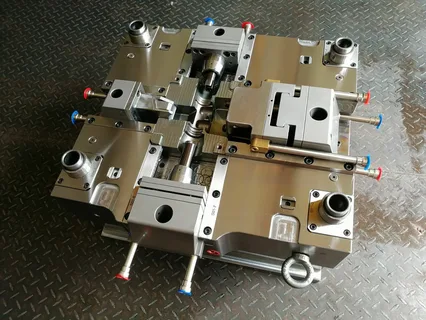Injection molding is one of the most popular and cost-effective manufacturing processes for producing plastic parts at scale. While the shape and function of a product are essential, its surface finish can significantly impact its usability, appearance, and performance. Understanding injection molded surface finishes is crucial for manufacturers, designers, and engineers to ensure a product meets aesthetic and functional requirements.
In this article, we’ll explore what injection molded surface finishes are, the types available, how they affect product quality, their industrial applications, and how to choose the right one for your project. Whether you are new to injection molding or a seasoned professional, this guide provides a comprehensive look into everything you need to know about Injection Molded Surface Finishes.
What Are Injection Molded Surface Finishes?
Injection molded surface finishes refer to the texture or appearance imparted onto a plastic part’s surface during the injection molding process. These finishes are achieved by texturing or polishing the surface of the mold cavity. When molten plastic is injected into the mold, it takes on the mold’s surface characteristics, resulting in a finished product with the desired visual and tactile properties. These finishes can range from high-gloss and mirror-like surfaces to matte, textured, or patterned appearances, depending on the design requirements.
Surface finishes serve both functional and aesthetic purposes. On the one hand, they can enhance the look and feel of the final product, making it more appealing to consumers. On the other hand, surface finishes can help hide imperfections such as weld lines or flow marks and improve grip or wear resistance. Therefore, selecting the appropriate Injection Molded Surface Finishes is not just a design preference—it’s a strategic decision that can impact product success in the market.
Common Types of Injection Molded Surface Finishes
There are several standard types of Injection Molded Surface Finishes, categorized based on industry standards such as SPI (Society of the Plastics Industry) and VDI (Verein Deutscher Ingenieure). SPI finishes, commonly used in North America, range from high-gloss A finishes to rough D finishes. A-grade finishes (like A-1 and A-2) are highly polished and ideal for transparent or high-gloss parts, while C and D grades offer matte or textured surfaces suitable for non-cosmetic parts or to improve grip.
VDI finishes, on the other hand, are more widely used in Europe and Asia. These finishes use a numerical scale (e.g., VDI 12, VDI 28) to define roughness and texture based on spark erosion or chemical etching. Higher VDI numbers result in rougher textures. These textures can be purely functional, such as preventing scratches or fingerprints, or decorative, offering visually unique surfaces. Selecting the right standard and type depends on the target market, part function, and desired aesthetics.
Impact of Surface Finishes on Product Performance
Choosing the right Injection Molded Surface Finishes goes beyond appearance—it can significantly affect the performance and functionality of a product. For example, a smooth, glossy surface may enhance visual appeal but could also make the product more slippery or prone to showing fingerprints and scratches. In contrast, a rough or textured surface might improve grip and hide wear, making it more suitable for tools, handles, or rugged devices.
Additionally, surface finish affects mold release, cycle time, and wear on the tooling. Highly polished surfaces require more maintenance and time to clean but may allow for quicker ejection of parts due to less friction. Rough textures may increase resistance during demolding, leading to longer cycle times and potential part defects. Manufacturers must strike a balance between aesthetic goals and production efficiency when deciding on Injection Molded Surface Finishes to maintain optimal cost and quality outcomes.
Industrial Applications of Injection Molded Surface Finishes
Injection Molded Surface Finishes are widely used across various industries to meet specific product requirements. In the automotive sector, finishes are used to match interior textures like dashboards, control panels, and trims. These finishes not only provide an appealing visual consistency but also help reduce glare and improve tactile feedback for drivers. In the medical industry, glossy and smooth finishes are often selected to ensure sterility and ease of cleaning, which is essential for patient safety and regulatory compliance.
Consumer electronics, such as smartphones and wearable devices, heavily rely on aesthetically pleasing and ergonomic finishes. Matte or soft-touch textures may be used to reduce fingerprint visibility and enhance user comfort. Meanwhile, in industrial and construction tools, rugged textures increase durability and provide a firm grip, even in harsh working conditions. Each sector utilizes Injection Molded Surface Finishes not just for looks but to enhance user experience, safety, and product longevity.
How to Choose the Right Injection Molded Surface Finish
Selecting the most appropriate Injection Molded Surface Finishes requires collaboration between design engineers, manufacturers, and marketing teams. Start by considering the product’s end-use—will it be touched frequently, exposed to the elements, or used in a sterile environment? These factors will influence whether a high-gloss, matte, or textured finish is more suitable. It’s also essential to account for the type of plastic being used, as different resins interact with mold finishes differently.
Budget, production volume, and lead times also play a role in choosing a finish. High-gloss and highly polished finishes require more time and cost to prepare the mold and maintain over time, while textured finishes might be more forgiving in terms of mold wear and part defects. Moreover, rapid prototyping and 3D rendering can be used to test how different Injection Molded Surface Finishes will appear and perform before full-scale production begins. Ultimately, the right finish balances function, form, and feasibility.
Conclusion
Understanding the intricacies of Injection Molded Surface Finishes is vital for producing high-quality, functional, and visually appealing plastic parts. From the wide variety of textures and industry standards to their direct impact on part performance, aesthetics, and usability, surface finishes should never be an afterthought in the product development process. The finish chosen can dramatically affect not only how a product looks but also how it performs, how long it lasts, and how it is perceived in the market.
Whether you’re working on automotive components, consumer gadgets, or industrial tools, the finish on your injection molded parts can be a game-changer. By familiarizing yourself with the available types, understanding their implications, and involving all stakeholders in the selection process, you can ensure that your product stands out in form and function. Make Injection Molded Surface Finishes a strategic part of your design and manufacturing workflow to achieve the best possible outcome.


